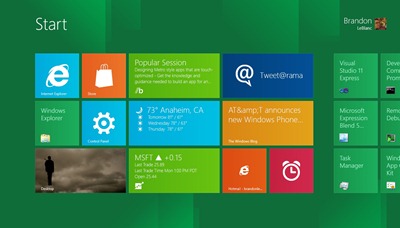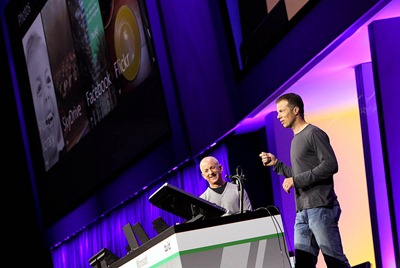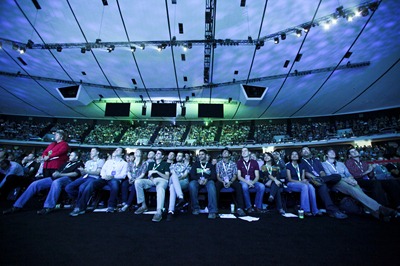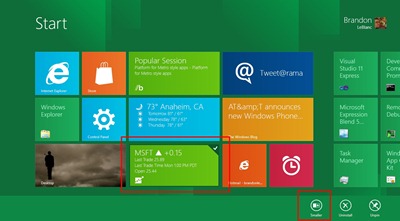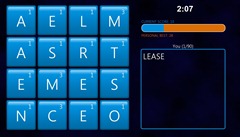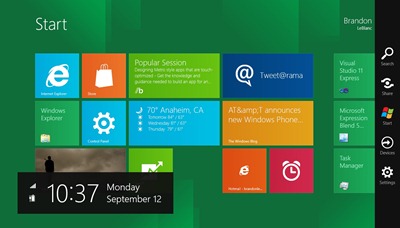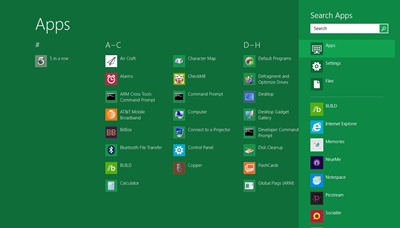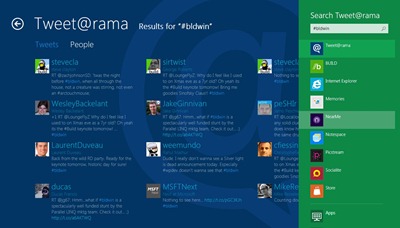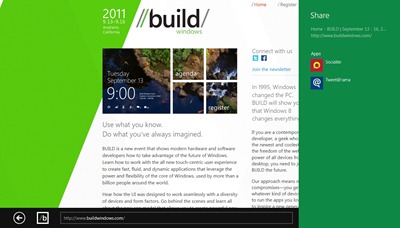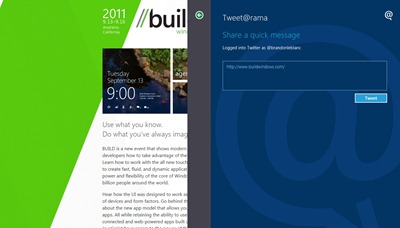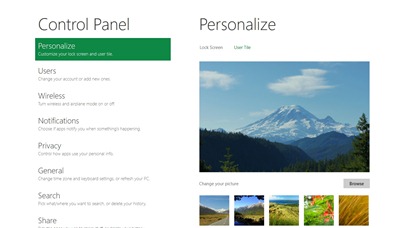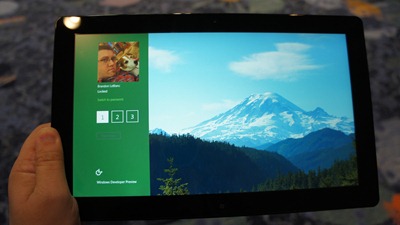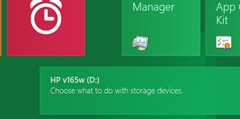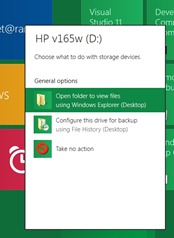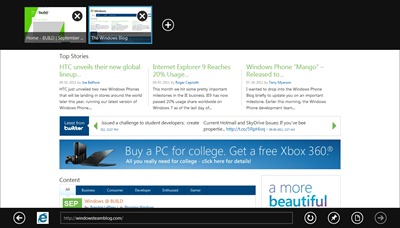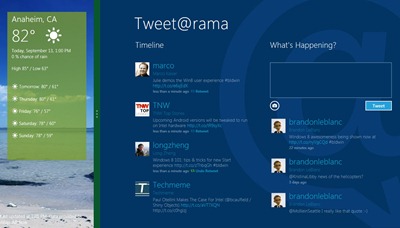The keynote finished a few hours ago at BUILD where Steven Sinofsky and other members of his engineering leadership team shared a detailed preview of the next major Windows release codenamed “Windows 8” to the thousands of developers in attendance here in Anaheim.
As I look around the room (and look at all the tweets), it seems that everyone is excited by what they just saw. As Steven said during the keynote, Windows 8 is computing reimagined. It’s Windows reimagined. We’re not just showing developers an early look at Windows 8; we’re also giving them access with a Developer Preview release. Steven Sinofsky has published a blog post on Building Windows 8 today that discusses the Developer Preview (including when and where to get it) and building apps for Windows 8 – I suggest reading the post for context.
I was given a chance to get my hands on the Samsung prototype PC with Windows Developer Preview we’re handing out to developers at BUILD today. This was my very first opportunity to play with the Windows 8 preview so once I got the PC, I rushed back to my hotel room eager to get started (it was like Christmas for a geek!).
My experience with the Windows 8 Developer Preview began at a new setup process that brings in the new Windows Metro design style. This is where I had to go through a series of screens to pick a name for my PC, connect to a wireless network, and then choose to sign in with my Microsoft account (my account I use to sign in to Hotmail, SkyDrive, etc.). In signing in with my Microsoft account, Windows 8 created my account on the PC based on profile information from Live such as first and last name and profile picture (which would later become my user tile at the top right of my Start screen). For signing in with my new user account in Windows 8 – it even used my Microsoft account password. Because I used my Microsoft account, I didn’t have to create a separate username or password for my PC. Your Windows 8 PC settings and apps will roam with you from one Windows 8 PC to another via Live – however that functionality is not currently enabled in the Windows 8 Developer Preview. While you can choose not to use your Microsoft account in setting up a new user account in Windows 8, you’ll definitely want to at least consider it for additional “cloud awesomeness”.
Once the process completed, I then signed in to my new user account in Windows 8.
Immediately upon signing in I’m taken to the Start screen of Windows 8’s new Metro style UI. This was a “wow” moment. The very first thing I did was take my finger and slide left to right. It was instinct. This is how you navigate the Start screen. Everything on the Start screen is on a single level. Everything was very responsive and quick. The Start screen is my gateway to all my apps and content on my PC. Instead of icons representing my apps, each app is represented by a tile. Unlike icons, these tiles can be live with activity from within the app. Instead of having to open the app and drill down into it, the most important information is surfaced through the app’s tile (a “Live Tile”). Why should I have to open a weather app just to see what the current weather is? In the above screenshot of my Start screen, you can see that I have several apps pinned to my Start screen that are displaying information.
It’s worth noting that the Start screen shouldn’t be considered a glorified “app launcher” – because it’s not. You can pin your favorite contacts, photo albums, music playlists, websites and more to the Start screen as well. Essentially – you can pin items from within apps to the Start screen. In the Windows 8 Developer Preview, some of this functionality isn’t there yet though.
During the keynote today, you saw several Live-connected apps such as Mail, Calendar, Photos, People, and Messaging that were demoed – these are not included in the Windows 8 Developer Preview.
I can customize the Start screen too. When I first logged into Windows 8, the Start screen was populated by apps that were included in the Windows 8 Developer Preview which included a handful of sample apps developed by interns that are designed to show off what can be done with apps in Windows 8. Below is a photo of many of those interns in the front row at today’s BUILD keynote!
Those apps include a weather app, stock app, news app, Tweet@rama, Socialite and more. It also included all the developer tools needed to begin making Windows 8 apps. Some of the apps I did not personally want on my Start screen. To remove those apps, all I had to do was take my finger and swipe down on the tile. 3 app commands appear from the bottom where I can choose to unpin the app.
Tiles can either be large (rectangular) or small (square). To resize a tile, you do the same thing as you would to unpin it by swiping your finger down over the tile.
Of the apps included in the Windows 8 Developer Preview, I really like Tweet@rama because I do a lot of tweeting (and reading tweets) and I have grown quite fond of the game Word Hunt where you use your finger to swipe out words under a certain time. And I also like Socialite.
These apps are what we’re calling Metro style apps (and they are different than your desktop app like Adobe Photoshop). They are full screen and completely immersive in the experience of the app. With Metro style apps, you can “immerse” yourself in the experience without having chrome getting in your way.
When I swiped from right to left on the right side of the screen with my finger, I noticed the clock and date showed up which includes icons for wireless connectivity and battery life on the lower left and then also a series of commands that slides out from the right. This icon bar has 5 of what we’re calling “charms” that provide access to essential Windows features: Search, Share, Start, Devices, and Settings.
If I ever want to search my PC for something, all I have to do is bring up charms and choose the Search charm. From there, I can search my PC for anything I want including apps, settings, and of course files.
However I can also search within apps too. For example – I wanted to check out all the latest tweets from BUILD using the #bldwin hashtag. I typed #bldwin into the search box, chose Tweet@rama and got tweets from people using that hashtag.
Everyone is sharing content with loved ones whether its photos in email or to Facebook or links to articles found online in a tweet. Windows 8 makes it easy for apps to share to each other. In my case, I wanted to share the link to the BUILD website from within Internet Explorer to Twitter.
I brought up the charms and clicked on the Share charm and then chose Tweet@rama and it automatically placed the link to the BUILD website into a message I then tweeted to my followers. The idea here is that Windows 8 can enable apps to work together to complete scenarios.
The Start charm is an easy way back to the Start screen.
With the Devices charm, this is where I can choose certain devices on which to share my photos, music, or videos or manage printers. I didn’t have any devices around me when I wrote this blog post to try this out unfortunately. Our hardware partners can write their own Metro style apps that can be utilized to manage their devices which can happen directly through this charm.
And of course the Settings charm gives me quick access to the settings within each app but also access to wireless networks, volume control, screen brightness, notifications (turn them off) and to shut down or restart your PC or put it to sleep.
To configure my PC just the way I want it – Windows 8 has a Metro style Control Panel app for quick access to what matters to customers, things like personalizing your Windows 8 PC by changing your user tile photo or lock screen background. I changed my lock screen background to one of my favorite shots of Mt. Rainier I recently took.
In regards to the lock screen – I discovered as I was going through options for the lock screen that you can choose a special app that displays a detailed status on the lock screen and up to 6 other apps that would display status badges. I can imagine seeing a status badge for a Twitter app letting me know I received a Direct Message or a “@” reply.
Windows 8 also allows you to create a “Picture Password” to unlock your PC from the locks screen (see above shot). Choose a photo and 3 points or gestures on that photo that will unlock your PC instead of using a password (although you can switch to password if you need to).
Other options in the Metro style Control Panel are wireless (you can put your PC into “airplane mode” when traveling), privacy for controlling which and how apps access your personal info, search history, share and send options, devices, PC sync, HomeGroup and Windows Update just to name a few.
Speaking of notifications, I got a first-hand look at how notifications work in Windows 8 by plugging in a USB drive. A little notification popped up at the lower right hand corner with a familiar Windows “ding”.
It asked me what I wanted to do with the storage device I just plugged in. I clicked on the notification and gave me a list of options to choose from.
Here is what the alarm notification looks like from the alarm sample app:
I can’t talk about Windows 8 without talking about Internet Explorer 10. In Windows 8, there is a Metro style version of Internet Explorer that makes web browsing so fast and fluid – especially with touch.
Internet Explorer 10 builds upon the awesome work we did with Internet Explorer 9 with web standards and GPU-accelerated HTML5. Web sites load quickly. You’ll notice in the above screenshot that I can easily switch between tabs in Internet Explorer on Windows 8. I can also pin my favorite websites directly within Internet Explorer or to my Start screen.
I found myself tweeting in Tweet@rama and someone I follow mentioned the weather in Seattle. Being that I’m in Anaheim, I wanted to check the weather here. Because I had opened the weather app earlier, to bring it up again all I had to do was swipe my finger from the left to right on the left side of the PC. Doing this lets me quickly go through my open apps.
However, I can also slowly pick a app from the left and ”snap” it while using another app so they run side by side. You’ll notice in the above screenshot, Metro style apps can run in a smaller window size when running snapped to another app (the main app). I was able to quickly look at the weather in Anaheim AND keep tweeting at the same time.
So what about desktop applications? Applications that ran on Windows 7 will run just fine on Windows 8. Matter a fact, for the writing of this blog post I went and downloaded Paint.NET for my screenshots. It installed flawlessly and once it was finished installing, it appeared on my Start screen just like any Metro style app would. I tapped on it and it fired up in Windows desktop just as it would in Windows 7. You still have your Windows desktop in Windows 8. It just behaves like an app on the Start screen.
One other thing to highlight: everything I talked about above was done using touch however I also went through the same scenarios and used a mouse and keyboard as well and it works just as well.
Eventually, developers building Windows 8 apps will be able to make their apps available for purchase and download via the Windows Store. However, the Windows Store is not available in the Windows 8 Developer Preview.
There is so much more in the Windows 8 Developer Preview than I can cover in this post. However I’ve decided to keep this focused on the new user experience of Windows 8. The Start screen is like what the Start button was to Windows 95. It really is a reimagining of Windows. I have to say that Windows 8 will change how I use the PC.
For a long time, I will remember the first time I logged in to Windows 8 and saw the Start screen come up. The Start screen is what I am most excited about right now with Windows 8 but then again I’ve only had less than a day to play with it. There is so much more to discover.


